This is part 2 of my December 2021 tour of the Ruth Bancroft Garden. Click here for part 1 and here for part 3.
⎯⎯⎯⎯⎯⎯⎯⎯⎯
The big metal shade structure you see in the photo below is located smack in the center of the garden. In the summer, it provides protection for plants that don't like to bake in the sun all day. In the winter, it is wrapped in plastic and becomes a shelter against the cold and excessive rain.
Part 3 of this tour will focus on the plants inside the structure. In this installment, I want to show you some noteworthy succulents growing on the mounds outside (on the right in the photo above).
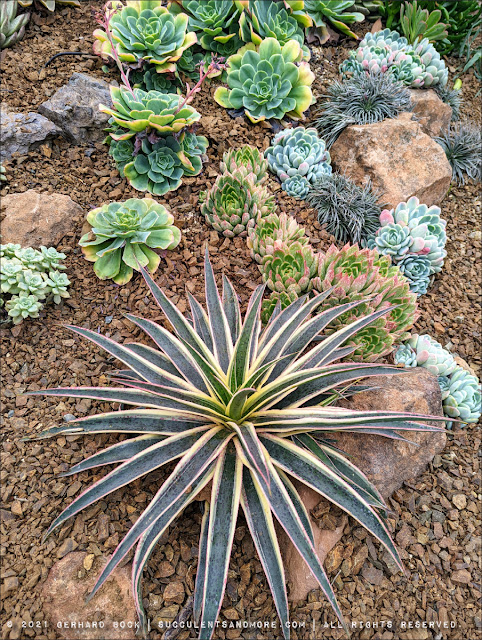 |
| Mangave ‘Snow Leopard’, multiple echeverias, and three Dyckia choristaminea |
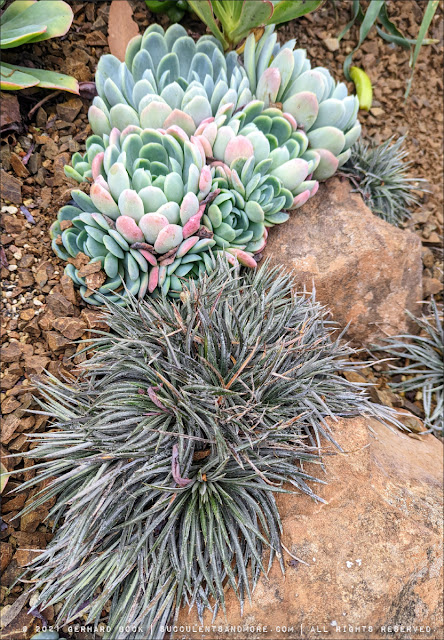 |
| Dyckia choristaminea and unidentified echeveria |
 |
| Boophone disticha, a South African bulb with a distinctive fan of leaves, surrounded by echeverias. In a few years, these echeverias will have formed dense colonies. |
 |
| Spiral aloe (Aloe polyphylla) planted on a slope and at an angle to prevent accumulation of moisture that might lead to rot. It’s a tricky aloe species to keep alive in a hot-summer climate because it is susceptible to pathogens active in warm moist soil. I'm curious to see how this specimen will fare. |
 |
| I can’t quite explain why, but I love this tapestry of green and blue leaves |
 |
| Gasteria acinacifolia, one of the largest gasterias and also one of the most sun-tolerant |
 |
| Aloe cryptopoda |
 |
Aloe cryptopoda with very unusual flowers. Typically, they’re straight, not curving like this.
|
 |
| Encephalartos horridus, a cycad from South Africa, surrounded by aloes, euphorbias, and mesembs |
 |
| Cactus land |
 |
| Another Boophone disticha, with Euphorbia stellispina on the right |
 |
| Euphorbia stellispina, well named (“stellispina” means star-shaped spine) |
 |
| Mammillaria geminispina forming clumps that beg to be touched (probably best not to, though) |
 |
| Crested Mammillaria sp. |
 |
| Ferocactus latispinus with its distinctive purple flowers |
 |
| These Opuntia lucotricha pads may be dead, but they're still striking |
 |
| Agave wocomahi, a cousin of Agave bovicornuta |
 |
| Yucca linearifolia surrounded by cacti |
 |
| Opuntia humifusa, flopped over as it's wont to do in the winter months. Commonly known as devil’s tongue or the eastern prickly pear, it has a very wide distribution, ranging from the Florida Keys all the way up to southern Ontario. |
 |
| This exceptional beauty is a hybrid between Agave colorata and Agave isthmensis made by Brian Kemble |
 |
| Agave colorata × Agave isthmensis |
 |
| Ruth Bancroft preferred these simple frames to protect tender plants (in this case Astrophytum cacti) in the winter, both against the cold and against excessive moisture |
 |
| I couldn't figure out what this was so I asked Brian Kemble for an ID. It turns out that it's a Mangave he created by pollinating Agave parrasana with pollen from a Manfreda hybrid of his called Manfreda 'Dit Dah'. Another seedling from this Mangave grex was given the cultivar name Mangave 'Blue Fountain.' |
 |
| Agave shrevei, grown from seed by Brian Kemble, and Yucca gloriosa ‘Bright Star’ |
 |
| Agave ‘Moon Glow’ and a staked cactus |
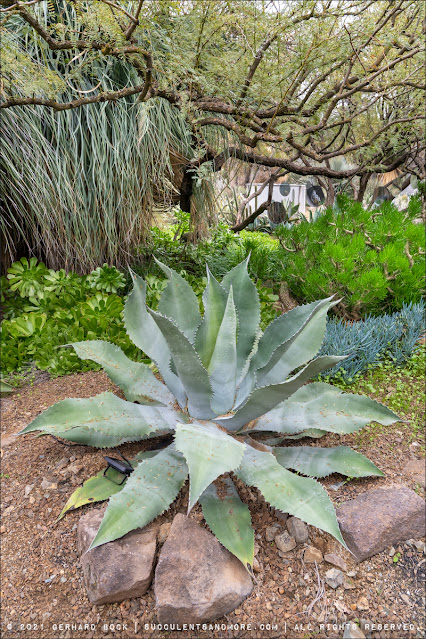 |
| Juvenile Agave ‘Mr. Ripple’ replacing the mature specimen that flowered a few years ago in this spot |
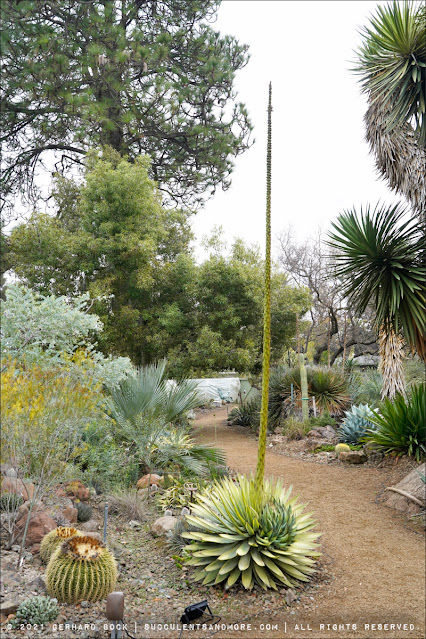 |
| Agave ‘Blue Glow’ with one bulbil at the top of the flower stalk... |
 |
| ...and lots of offsets emerging from the center of the rosette |
 |
| Ever expanding clump of Agave ‘Cornelius’ |
 |
| Aloe striata clump |
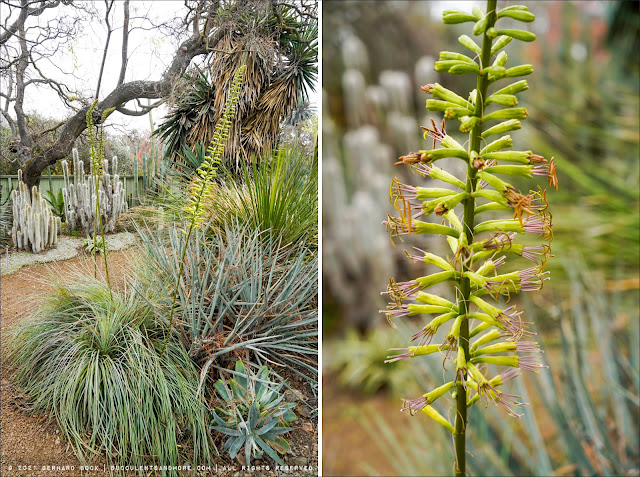 |
| Several of these Agave striata are flowering; close up of inflorescence on the right |
 |
| Sempervivum arachnoideum forming a dense carpet in front of Cleistocactus straussii |
 |
| Sempervivum arachnoideum |
 |
| (Right) Opuntia tomentosa, a prickly pear of tree-like proportions |
 |
| Spectacular specimen of a Queensland bottle tree (Brachychiton rupestris) |
 |
| Queensland bottle tree (Brachychiton rupestris) underplanted with cacti including Parodia magnifica |
 |
| White-flowering Aloe ferox pushing an inflorescence |
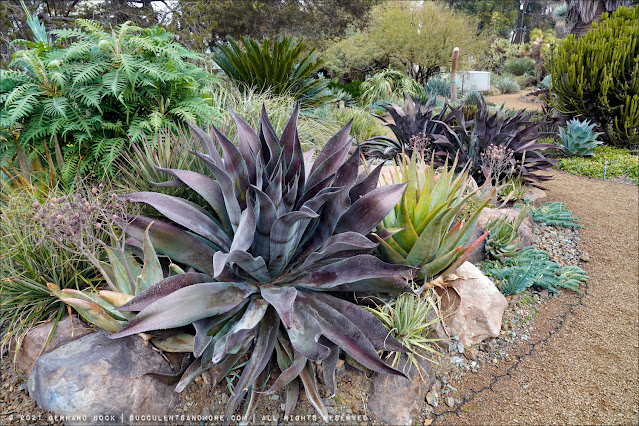 |
| Mangave ‘Mission to Mars’, impressive in its near-mature size. Notice two others on the top right. The aloe to the right is Aloe schoelleri (Eritrea). Top left is Sonchus palmensis, a dandelion relative from the Canary Islands. |
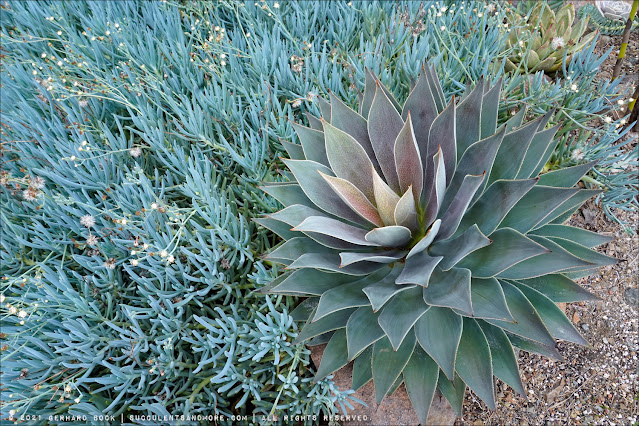 |
| Mangave ‘Lavender Lady’ and Curio talinoides var. mandraliscae (the current name of what used to be known as Senecio mandraliscae) |
 |
| The pond was completely redone a couple of years ago |
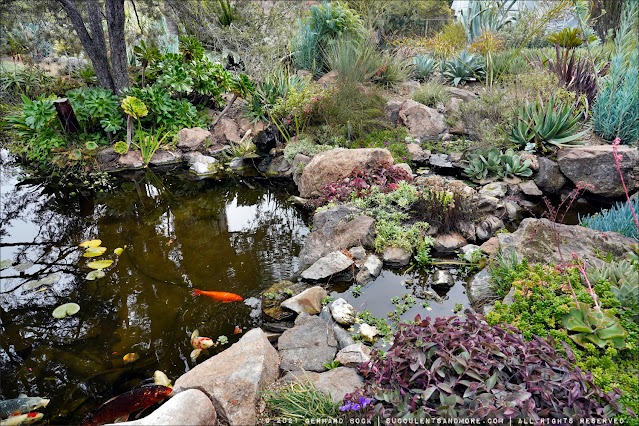 |
| It's surrounded by a large variety of soft-leaved succulents |
 |
| A sea of aeoniums in the area adjacent to Ruth’s Folly, the wooden structure that was the original entrance to the garden and is now being renovated |
 |
| Aloe schelpei (Ethiopia) |
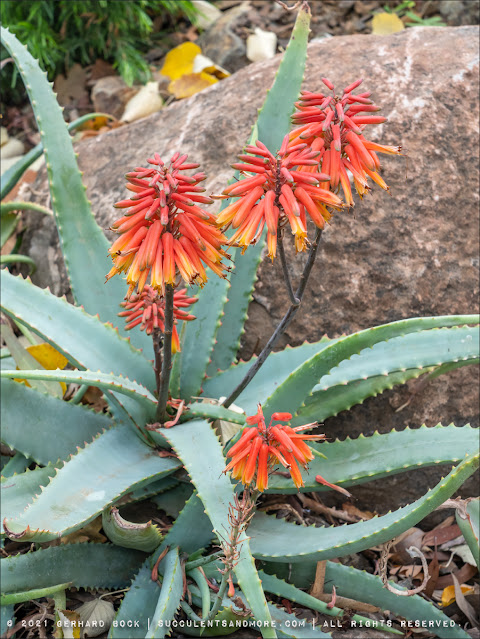 |
| Aloe schelpei (Ethiopia) |
 |
| Another beautiful aeonium, all plumped up after the recent rains, surrounded by smaller soft-leaved succulents and grasses |
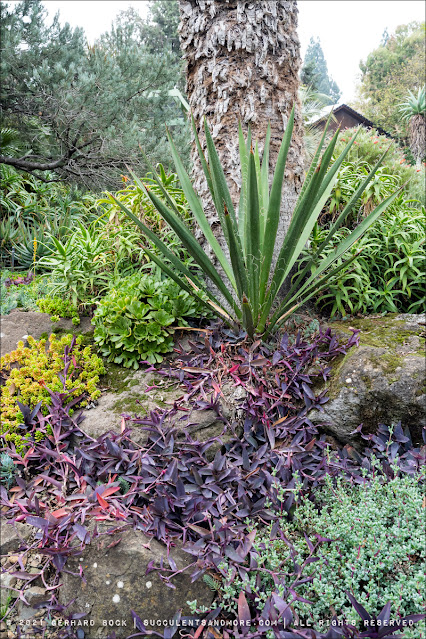 |
| Tradescantia pallida ‘Purple Heart’ and Oscularia deltoides |
The garden's central shade structure underwent a complete renovation in 2020 (
see this post). In the
final installment of this series, I'll take you inside the shade structure. It's home to some pretty special treasures!
RELATED POSTS:
© Gerhard Bock, 2021. All rights reserved. To receive all new posts by email, please subscribe here.

















































I have my Gasteria acinacifolia in a northern exposure here in Phoenix but I wonder if I can move it to eastern. I also wonder if Yucca gloriosa 'Bright Star' turns reddish in cool winter weather. I had Aloe 'Margaritaville' and my gardener overwatered it and it rotted. I have looked for it everywhere but it is totally gone from production. I wondered if Bright Star is similar to it. I also wonder if that Mangave will die after flowering. Finally, just want to say I love Aloe schelpei and never heard of it before.
ReplyDeleteAt UC Davis, they have Gasteria acinacifolia growing in full sun, so I'd think it would handle eastern exposure just fine in Phoenix. It's probably the toughest (and best) gasteria for landscaping.
DeleteI can send you a small Yucca 'Margaritaville' if you'd like. I remove mine a few years ago, but I still have suckers coming up from small pieces of roots left in the ground.
Yucca 'Bright Star' is different because it doesn't get tall like 'Margaritaville'. It's supposed to be a form of Y. gloriosa. It does get pink overtones in cold weather.
Aloe schelpei is uncommon in cultivation. I don't know why. Since it offsets, propagation shouldn't be an issue.
Yes, yes, yes, please send me the Yucca 'Margaritaville', Gerhard! Hoover Boo kindly sent me a few small ones in 2019 and they were doing great until we hit the hottest summer on record in Phoenix, I was out of the Valley and they were still small and didn't make it. Believe me, this time I will be beyond careful! I sent you a friend request on Facebook quite awhile ago but haven't heard back on it. I could go on Messenger there and give you my address. Does that work? I will pay you the shipping cost.
DeleteQueensland bottle tree is outstanding. What an unusual massive trunk. And then there is Aloe schelpei planted in the reddish rock, and blooming! It doesn't get more beautiful than that. Once in a blue moon I see in your post something I also grow, today I hit the daily double: Sempervivum arachnoideum in my garden and (tiny) Gasteria indoors.
ReplyDeleteThat Queensland bottle tree has got to be almost 50 years old. I don't know when it was planted.
DeleteSo many wonderful specimens and vignettes. I couldn't help wishing my local botanic garden worked harder at creating effective pairings within their succulent garden. I love that Aloe schelpei and I hope my puny Mangave 'Mission to Mars' looks half as good as the one in the Bancroft garden someday.
ReplyDeleteThe Ruth Bancroft Garden has great people moving it forward. People with passion and vision. I'm sorry that both seem to have gotten lost a bit at South Coast Botanic Garden.
DeleteYour Mangave 'Mission to Mars' will look like that eventually. Just give them as much such as you can.
I love how the plants are put together, each partner highlighting the other. Lots of great textures going on. Looking at photo #6 I find it striking not only for the combinations of green and blue photos but the striking textural differences especially with the blue palm in the center. Gorgeous!
ReplyDeleteSo many beautiful combinations. A lot of thought went into this.
DeleteI love the plantings they installed around that end outside the shade structure. My Blue Glow is really mature now-I keep peering at it wondering if it will bloom.
ReplyDeleteI'm wondering the same about my 'Blue Glow'. It actually looks just about perfect. That's usually when they bloom--just to annoy you, ha ha!
Delete